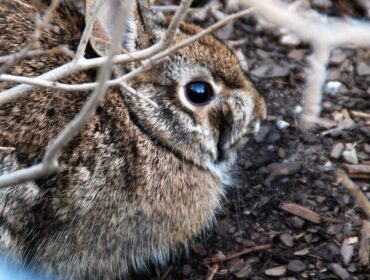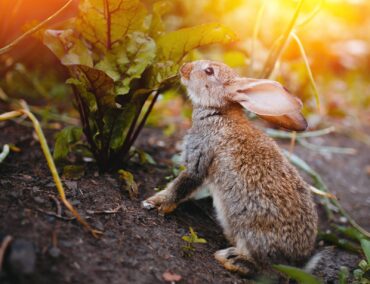
Rabbits are year-round and frequent visitors to gardens and landscapes. As children, we read about and adored these furry critters. This love of rabbits often fades as we grow older and experience damage to our gardens and landscapes. Employing various management strategies allows us to coexist with these cute yet voracious members of our community.
Rabbits eat a wide range of plants including flowers, vegetables and weeds throughout the spring and summer. As these plants fade in fall, they begin dining on trees and shrubs. You may find bark gnawed, evergreen needles nibbled and branches, stems and buds clipped off the plants.
Their sharp teeth make a clean cut, much like a bypass pruner at a 45-degree angle. Rabbit damage usually occurs within 3 feet of the ground, where they can easily reach and dine on the plants. Look for tracks and droppings, often called pellets, if additional clues are needed. The pellets are little, round, hard and usually yellowy brown to green.
Our landscapes provide the perfect habitat for rabbits. They tend to concentrate in open grassy areas that have patches of desirable cover like brush piles, shrubs and gardens that provide an escape from predators.
 These short-lived mammals tend to be very productive, giving birth to two to six litters of four or more babies in a season. Diseases, weather, predators, hunters and cars help limit the number of surviving offspring.
These short-lived mammals tend to be very productive, giving birth to two to six litters of four or more babies in a season. Diseases, weather, predators, hunters and cars help limit the number of surviving offspring.
Start by removing hiding places like brush piles, weed patches and stone piles that provide places for rabbits to live and hide. Work with your neighbors, who may not realize they are housing rabbits feeding in both of your yards. Leave a few weeds and perhaps some clover in the lawn as an alternate food source for them.
You will find lists of rabbit-resistant plants, but as gardeners know, they will eat just about any plants when populations are high and food is scarce. Protecting key gardens and plants will help reduce the risk of damage and increase your enjoyment.
Fencing is an effective management strategy but may not be practical or aesthetically pleasing. When employing fencing, be sure it’s high enough to keep rabbits out and the openings are 1 inch or less. A 3-foot-tall fence with an outward baffle at the top or one 4-foot tall is more effective.
Secure the fence tight to the ground or bury the bottom few inches to prevent rabbits from crawling under. Check the gate, adding flaps and sweeps as needed to prevent rabbits from gaining access to the garden.
Use 4-foot-tall cylinders of hardware cloth around young trees and shrubs to prevent damage. Place the cylinder several inches away from the trunk and bury the bottom few inches in the soil to prevent rabbit and vole damage.
Repellents are a less obtrusive option and more practical for many gardeners. Select a product labeled for rabbit control and preferably an organic option like Plantskydd. This odor-based repellent is rain and snow resistant, so you will need to reapply less often. Whenever possible, apply repellents before the rabbits begin feeding and follow the label directions for the best results.
Evaluate and adapt your landscape design as needed and continually monitor for damage. Employ various strategies to help reduce rabbit damage while boosting your enjoyment and garden’s productivity.

























